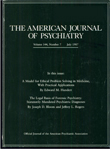Biological Psychiatry, 2nd ed.
The second edition of Biological Psychiatry comes 9 years after its predecessor. The 12 chapters can be categorized into three major sections. The first reviews historical underpinnings, conceptual models of disease evolving into modern nosology, principles of brain function and structure relevant to psychiatry, and investigative techniques (e.g., clinical, biochemical, and neuroimaging). The second discusses the major psychiatric disorders from a biological perspective. The third reviews both pharmacological and somatic treatments.
Historically, Hughlings Jackson may be one of the most influential early theorists. He depicted the nervous system as developing in space and time and possessing a hierarchical organization; he also hypothesized that tissue destruction led to the development of negative symptoms and that the release of activity in nearby healthy tissue led to positive symptoms. Karl Jaspers' distinction between process and development is also seminal. Steeped in the philosophical school of phenomenology, Jaspers attempted to dispel the confusion between form and content, emphasizing a descriptive psychopathology rather than actual diseases. Dr. Trimble opines that these contributions have important implications for our understanding of structural and functional aspects of the central nervous system in both normal and disease states.
Dr. Trimble provides concise reviews of genetics, brain chemistry and metabolism, the synapse, and the classic receptor-ligand interface. He then considers neuroanatomy, with a focus on the limbic system and associated structures, which have been of critical importance in the development of biological psychiatry. In this context, there are discussions on such topics as aggression, anxiety, memory, sexuality, and motivation as primary examples of the relationships among brain structure, brain function, and behavior.
The author also describes the role of the laboratory, including biochemical, neurophysiological, and neuroimaging techniques. Dr. Trimble notes that imaging studies in particular have done much to further our appreciation of potential neural networks, emphasizing the holistic nature of cerebral activity associated with such cognitive functions as memory, language, and emotional recognition.
Dr. Trimble's review of neurological syndromes associated with the limbic and related systems serves as the context in which to consider the major psychiatric diagnostic categories. For each major disorder, he provides a qualitative review of the relevant literature, which usually incorporates previously described investigative techniques. The two chapters on epilepsy and the dementias carefully delineate the overlap among these “classic” neurological disorders and the major psychiatric conditions. In this context, similarities in genetic studies (e.g., greater risk of schizophrenia, bipolar disorder, and Alzheimer's disease in monozygotic twins), relevant neurotransmitter systems (e.g., dopamine in Parkinson's disease, Huntington's disease, and schizophrenia), and pharmacotherapeutics (e.g., anticonvulsants in epilepsy and bipolar disorder) are considered. Further, the author also provides data to support the localization of certain psychopathology (e.g., left-sided temporal lobe lesions are more closely associated with schizophrenia-like psychosis; right-sided abnormalities may be more closely linked to affective disorders).
The last chapter focuses on pharmacological therapies, including discussions on pharmacokinetics, pharmacodynamics, the major psychotropic classes, and somatic therapies such as ECT, sleep deprivation, and psychosurgery.
Although this book contains a wealth of information, I felt there was a need to better integrate the previous body of data with the more recent findings of molecular and cellular biology. One senses a hesitancy in this work, as if standing at the threshold of yet another revolution but still glancing backwards. Indeed, the gap described by the author between the psychological and biological models may be even greater between the biological model emphasized in the first and second editions of this work and disease as conceptualized within the framework of a molecular-cellular biological paradigm. Further, such a perspective would lend itself to a discussion about the development of novel therapeutics targeting aberrant processes at this level, providing an appropriate acknowledgment of how far and in what direction the neurosciences and their potential promise of clinical applications have come in the past decade.
In summary, students wishing to achieve a historical perspective, an appreciation of the relevant neuroanatomy and neurochemistry (up to the neurotransmitter receptor-interface), and a comprehensive description of the major psychiatric and neurological disorders will find this work useful. Those wishing to further their expertise in biological therapies and/or their understanding of molecular and cellular biological concepts would be better served elsewhere (1, 2).
1 Hyman S, Nestler EJ: The Molecular Foundations of Psychiatry. Washington, DC, American Psychiatric Press, 1993Google Scholar
2 Duman RS, Heninger GR, Nestler EJ: A molecular and cellular theory of depression. Arch Gen Psychiatry 1997; 54:597–606Crossref, Medline, Google Scholar



